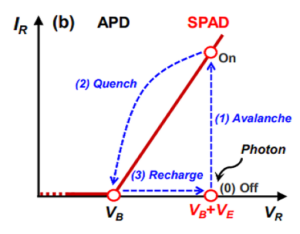With high-sensitivity and good timing-resolution, single-photon avalanche diodes (SPADs) attract increasing attentions in the past two decades as their integration with low-cost CMOS technology has been realized. One of the most eye-catching applications is serving as the receiver of time-of-flight ranging. In this group, we aim for developing high-performance SPAD chip for vehicle LiDAR based on our current 128×64 pixel array. The photon detection efficiency (PDE) of current SPAD array is limited by the low filling factor (FF) that is the ratio of sensing area to total array area. By applying several approaches to increase FF, including the tightened layout design, the new array structure, and the nano-photonics using periodic metal nano-structures in CMOS process, the array PDE could be significantly improved. In addition, to be prepared for the various LiDAR applications in the future, we will also investigate CMOS SPADs for the longer wavelength. Because the eye-safe power level of ranging lasers at 1550 nm is six orders higher than that at 905 nm, a CMOS SPAD working at this wavelength will be a game changer for the LiDAR applications.
